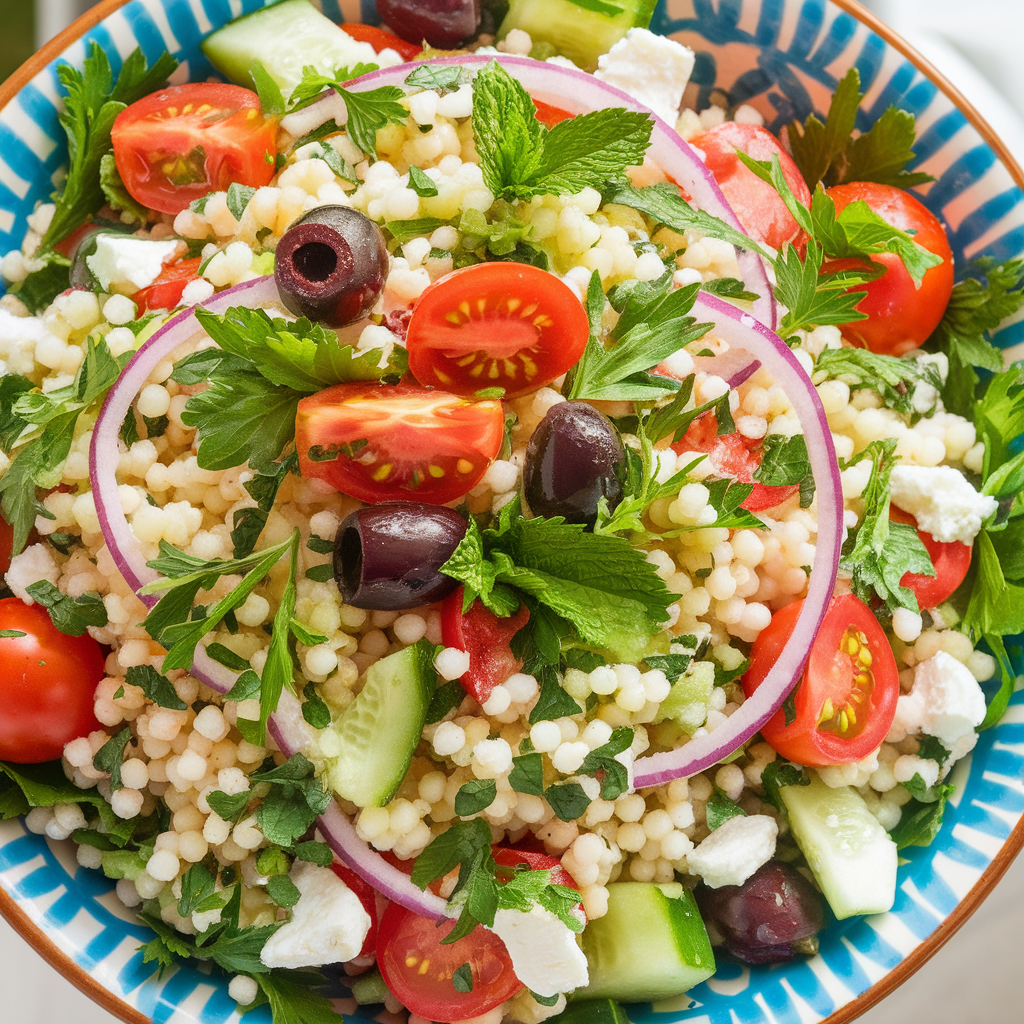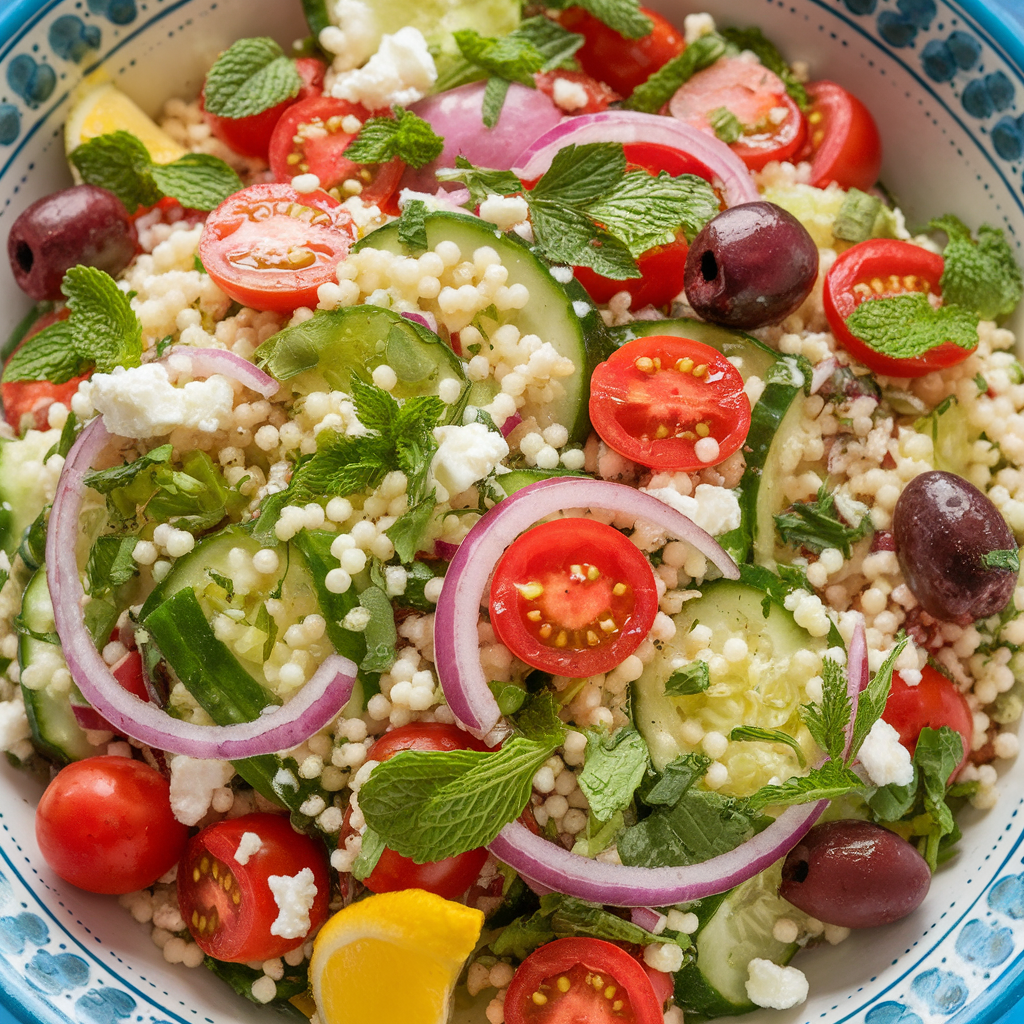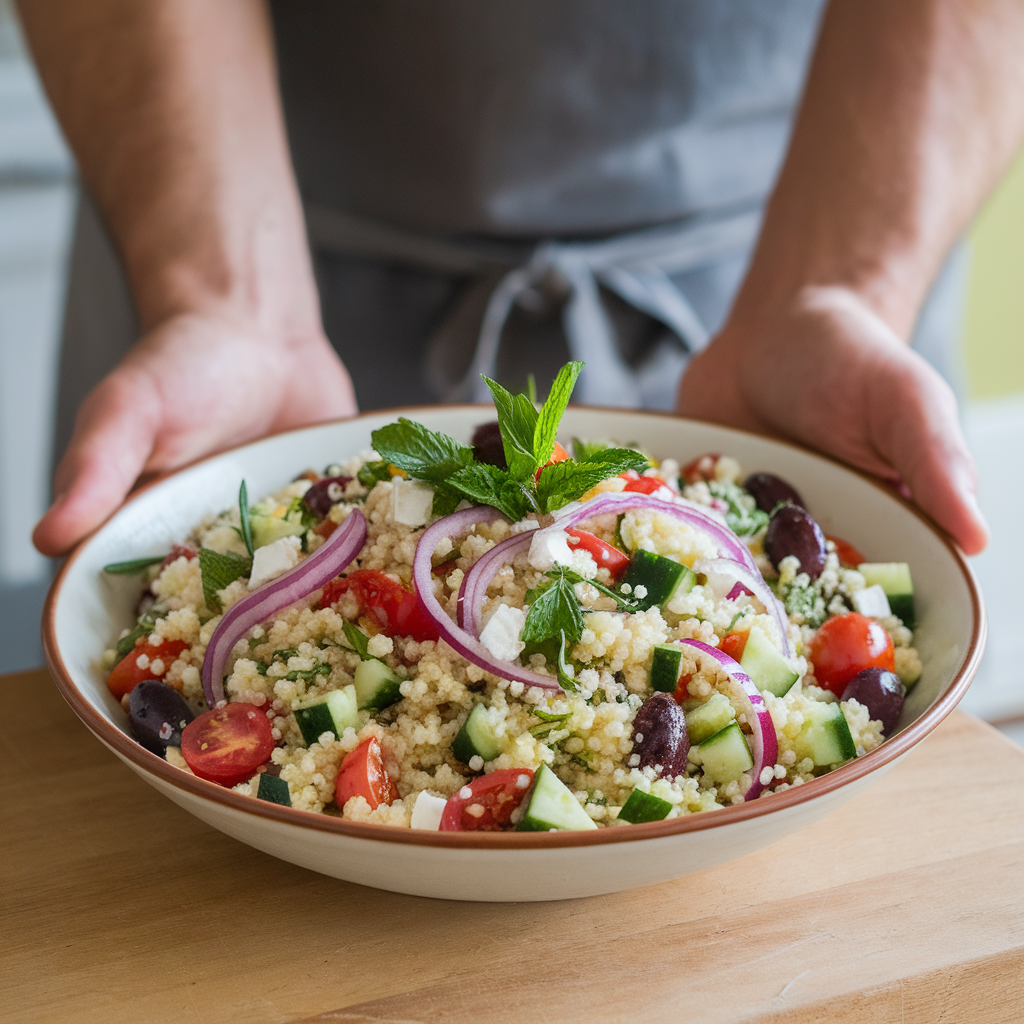
Few dishes capture the spirit of Mediterranean cuisine like the humble yet vibrant Mediterranean Couscous Salad. This colorful salad is a celebration of fresh ingredients, bright herbs, and wholesome grains, combining nutrition and taste in one bowl. Whether you’re searching for easy salad couscous recipes, craving a healthy lunch, or hunting for recipes using leftover couscous, this Mediterranean classic is a must-try.
In this comprehensive guide, you will learn everything you need to know about this salad: its origins, health benefits, step-by-step preparation, and creative variations including Couscous Quinoa Salad and Greek Couscous Recipes. Plus, discover how to make it vegetarian-friendly, store it properly, and customize it to your liking!
A Brief History of Couscous and Its Role in Mediterranean Cuisine
Couscous originated from North Africa, especially the Maghreb region, which includes Morocco, Algeria, Tunisia, and Libya. Traditionally, couscous is made by rolling durum wheat semolina into tiny granules, which are then steamed until fluffy. It’s a staple food in these cultures, often served with hearty stews, grilled meats, or vegetables.
The Mediterranean diet, celebrated for its health benefits, uses couscous extensively as a base for salads and side dishes. Over time, Mediterranean couscous salads evolved to incorporate fresh, local produce and Mediterranean flavors — such as olives, lemon, garlic, and herbs — resulting in the beloved dish enjoyed worldwide today.
Why You Should Add Mediterranean Couscous Salad to Your Recipe Box
- Versatility: It can be served as a main dish, side, or snack.
- Quick Preparation: Couscous cooks in minutes, making it perfect for busy days.
- Nutrient-Rich: Packed with fiber, vitamins, and antioxidants.
- Diet-Friendly: Easy to make vegetarian, vegan, or gluten-free (with quinoa substitution).
- Deliciously Fresh: The combination of herbs and citrus makes it refreshing.
Understanding the Ingredients: What Makes Mediterranean Couscous Salad Special?
Couscous – The Grain Base
Couscous acts as the neutral, fluffy grain base that absorbs the flavors of the salad. When cooked properly, each grain is light and separate, providing a perfect canvas for other ingredients.
Pro tip: Using vegetable broth instead of water to cook couscous adds a depth of flavor.

Fresh Vegetables
Common vegetables include cucumber, cherry tomatoes, red bell peppers, and red onions. They add crunch, juiciness, and vibrant color.
Olives and Feta Cheese
Kalamata olives bring a briny, salty note that complements the fresh veggies. Feta cheese adds creaminess and tang. Both are iconic Mediterranean ingredients.
Herbs – Parsley and Mint
Fresh herbs elevate the dish, lending a burst of aromatic freshness. Parsley provides a mild, slightly peppery flavor, while mint adds a cool, refreshing twist.
Dressing
A simple dressing of extra virgin olive oil, lemon juice, garlic, salt, and pepper brings everything together. Olive oil adds healthy fats, lemon juice contributes acidity, and garlic offers a subtle pungency.
The Complete Mediterranean Couscous Salad Recipe
Ingredients:
- 1 cup couscous
- 1 cup boiling vegetable broth or water
- 1 cup cherry tomatoes, halved
- 1 medium cucumber, diced
- 1/2 red bell pepper, diced
- 1/4 cup red onion, finely chopped
- 1/4 cup Kalamata olives, pitted and sliced
- 1/4 cup crumbled feta cheese (optional)
- 2 tbsp fresh parsley, chopped
- 2 tbsp fresh mint, chopped
- 3 tbsp extra virgin olive oil
- Juice of 1 lemon
- 1 clove garlic, minced
- Salt and freshly ground black pepper, to taste
Instructions:
- Prepare couscous:
Place couscous in a heatproof bowl. Pour boiling broth or water over couscous, cover tightly, and let stand for 5 minutes. Fluff with a fork to separate the grains. - Prep vegetables:
While couscous is resting, chop the tomatoes, cucumber, red bell pepper, onion, and olives. - Make the dressing:
Whisk olive oil, lemon juice, minced garlic, salt, and pepper in a small bowl. - Combine salad:
Add chopped vegetables, herbs, and feta to the couscous. Pour dressing over the salad and toss gently but thoroughly. - Chill and serve:
Refrigerate for at least 30 minutes before serving to allow flavors to meld. Serve chilled or at room temperature.
Pro Tips for the Perfect Couscous Salad
- Fluff couscous with a fork: Prevents clumping and keeps texture light.
- Use fresh herbs generously: Don’t skimp on parsley and mint — they add freshness and aroma.
- Add nuts or seeds: Toasted pine nuts, almonds, or sunflower seeds provide crunch.
- Balance flavors: Adjust lemon juice and salt to your taste.
- For spiciness: Add a pinch of chili flakes or cayenne pepper.
- Make it a meal: Toss in grilled chicken, chickpeas, or cooked shrimp.

Exploring Couscous Quinoa Salad: A Protein-Packed Couscous Alternative
If you want to boost the protein and nutrient content of your couscous salad, consider adding quinoa, a seed rich in complete protein and fiber. The resulting Couscous Quinoa Salad offers:
- More texture complexity (nutty quinoa with fluffy couscous)
- Higher protein content (especially great for vegetarians and vegans)
- Added minerals like magnesium, iron, and zinc
How to prepare: Cook equal parts couscous and quinoa separately according to package instructions, then mix and toss with your favorite Mediterranean salad ingredients.
Greek Couscous Recipes: A Delicious Spin on the Classic
Greek cuisine shares many ingredients with the Mediterranean palette, so it’s natural that Greek Couscous Recipes are a popular variation.
Features include:
- Fresh cucumber, tomatoes, and red onion
- Kalamata olives and capers for salty tang
- Crumbled feta cheese, often more generously added
- Dried oregano or fresh dill as herbs
- Lemon and olive oil dressing, sometimes with a splash of red wine vinegar
Some recipes add diced roasted red peppers, artichoke hearts, or even sun-dried tomatoes.
Vegetarian Couscous Salad: Nourishing and Meat-Free
Mediterranean couscous salad is naturally vegetarian when you include feta cheese and no meat. To keep it fully vegetarian and filling:
- Add plant proteins like chickpeas, lentils, or white beans.
- Include roasted vegetables such as eggplant, zucchini, or carrots.
- Use nuts, such as toasted walnuts or almonds, for extra texture and nutrition.
Recipes Using Leftover Couscous: Save Time and Reduce Waste
Leftover couscous is a treasure trove for quick meals. Here are some inspiring ideas:
- Mediterranean Couscous Salad: Toss leftover couscous with fresh diced veggies, herbs, and a simple vinaigrette.
- Stuffed Vegetables: Use couscous mixed with herbs and cheese to stuff tomatoes, bell peppers, or zucchini, then bake.
- Couscous Patties: Mix couscous with eggs, herbs, and spices, form into patties, and pan-fry for a crispy snack.
- Couscous Stir-Fry: Sauté leftover couscous with vegetables, garlic, and soy sauce for a Mediterranean-inspired stir-fry.
- Soup Add-In: Stir couscous into vegetable soups for added heartiness.

Salad Couscous Recipes Easy to Make at Home
For those short on time, here are quick couscous salad recipes easy to whip up:
Lemon Herb Couscous Salad
Simply toss couscous with lemon juice, olive oil, chopped parsley, and a pinch of salt. Serve with grilled chicken or fish.
Roasted Vegetable Couscous Salad
Roast diced eggplant, zucchini, and cherry tomatoes with olive oil and herbs, then mix with couscous and a drizzle of balsamic vinegar.
Chickpea and Couscous Salad
Combine canned chickpeas with couscous, diced cucumbers, tomatoes, red onion, and a cumin-spiced lemon dressing.
How to Store and Reheat Couscous Salad
- Store leftover salad in an airtight container in the refrigerator.
- It keeps well for up to 3 days.
- Because couscous absorbs dressing over time, you may want to add a little fresh olive oil or lemon juice before serving leftovers.
- Serve chilled or at room temperature for best flavor.
- Avoid freezing couscous salad as texture will degrade.
The Nutritional Powerhouse: Why Mediterranean Recipes Couscous Are Healthy
Mediterranean diets are renowned for reducing risks of chronic diseases like heart disease, diabetes, and obesity. This is thanks in part to:
- Whole grains like couscous: providing complex carbohydrates and fiber.
- Olive oil: a source of monounsaturated fats that improve cholesterol levels.
- Fresh vegetables: loaded with vitamins, antioxidants, and minerals.
- Lean protein: through additions like chickpeas or grilled fish.
Thus, Mediterranean couscous salad fits perfectly into a balanced diet promoting long-term health.
Frequently Asked Questions (FAQs)
Can I substitute couscous with quinoa?
Yes, especially if you want a gluten-free or higher-protein option. Quinoa cooks similarly and offers a slightly nuttier flavor.
Is this salad suitable for meal prep?
Absolutely. The salad can be refrigerated for several days. Keep dressing separate if you want the veggies to remain crisp longer.
Can I make it vegan?
Yes. Simply omit the feta cheese or replace with vegan cheese or toasted nuts for creaminess.
What are some easy ways to add protein?
Try chickpeas, grilled chicken, shrimp, or tofu cubes.
Final Words: Your Go-To Mediterranean Salad for Any Season
The Mediterranean Couscous Salad is a timeless, nutritious dish perfect for any meal. Its versatility allows endless customization to suit your tastes and dietary needs. From quick salad couscous recipes for busy days to elegant Greek couscous recipes for entertaining guests, this salad shines every time.
Use leftover couscous creatively and embrace the health benefits of Mediterranean flavors. With simple ingredients and minimal cooking, you can enjoy fresh, vibrant meals packed with nutrition and deliciousness.
Give this recipe a try, and let the Mediterranean sunshine brighten your plate and your day! 🥗🌿🍋




